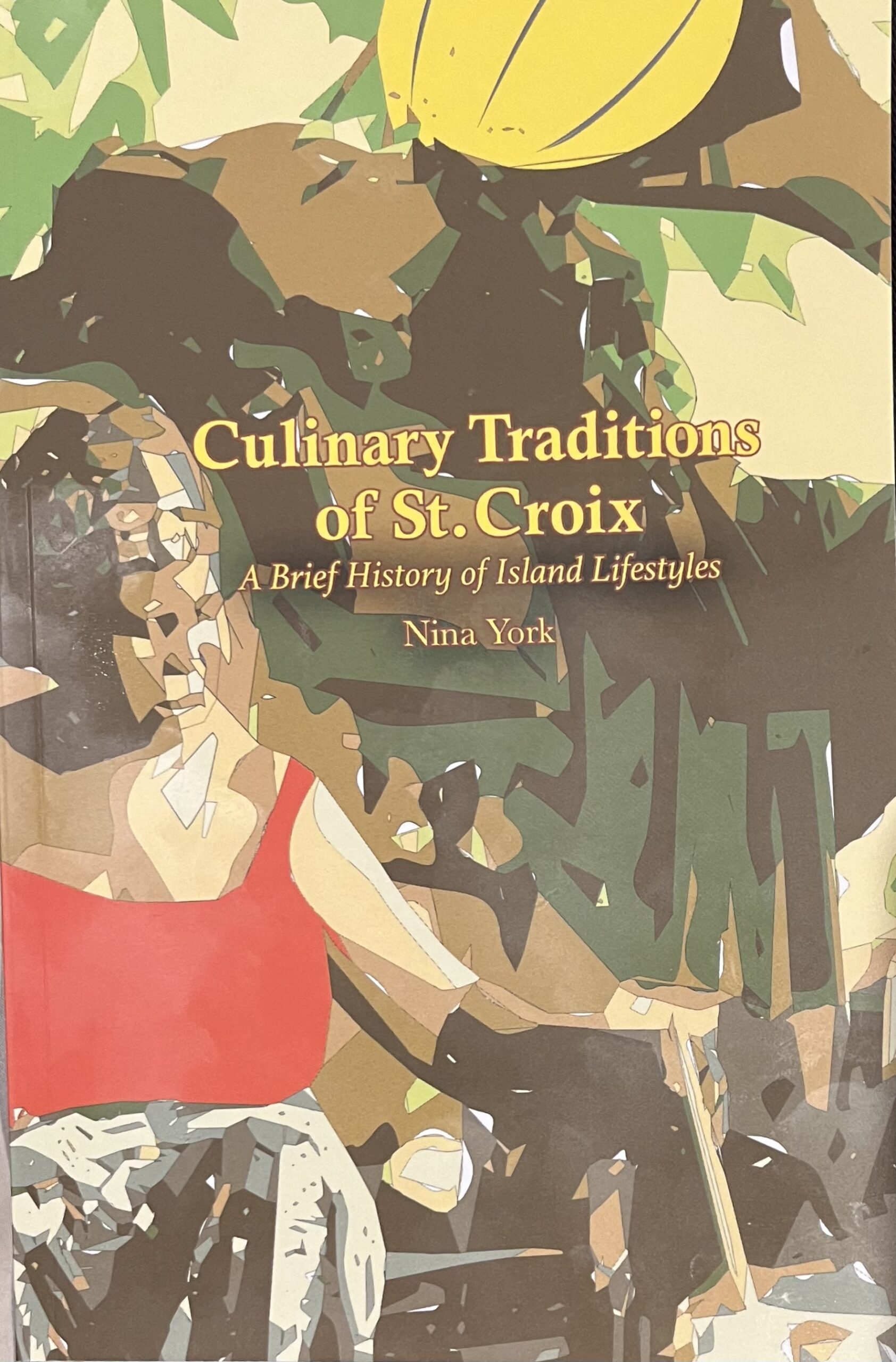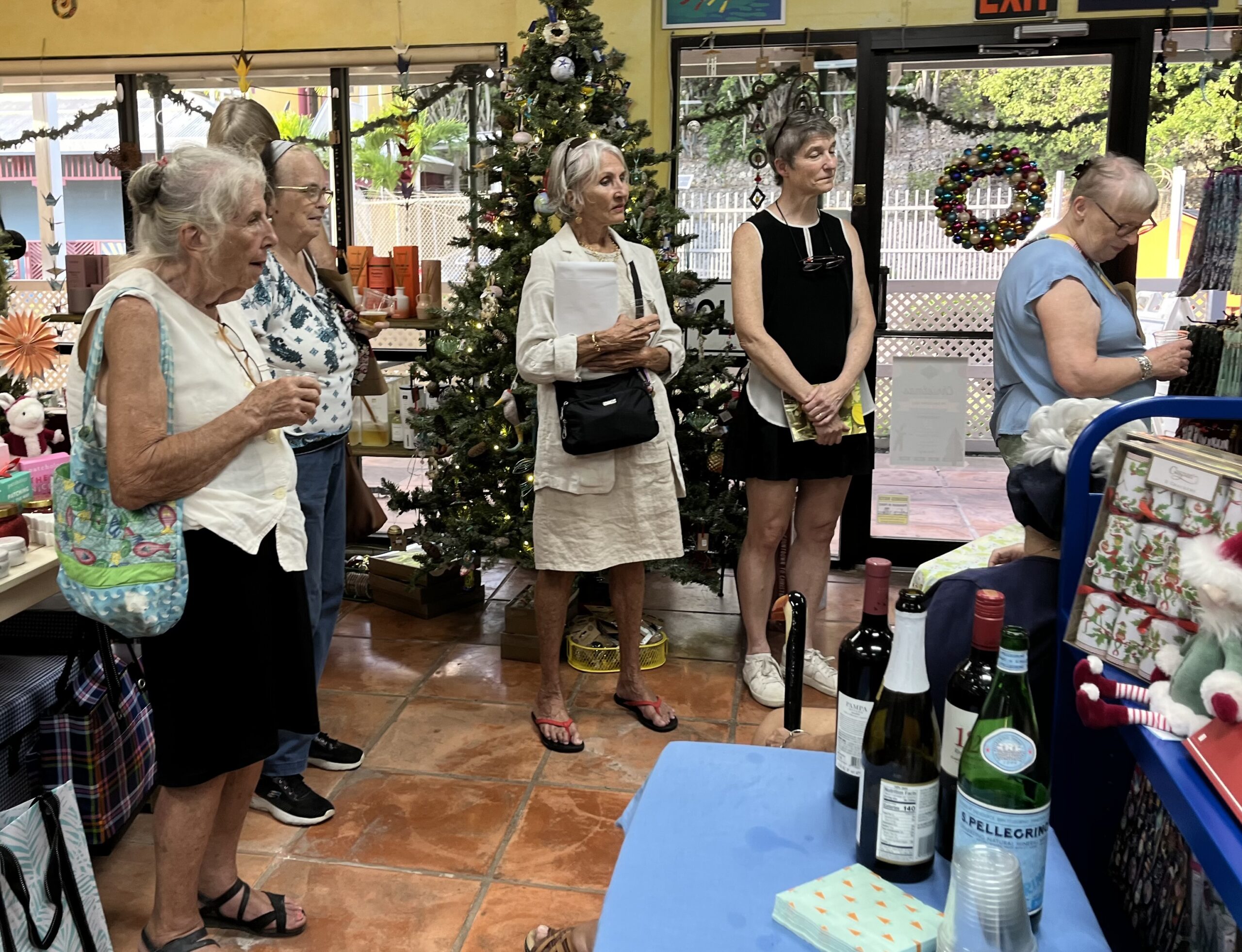Nina York’s new book “Culinary Traditions of St. Croix: A Brief History of Island Lifestyles” is on the shelves at Undercover Books & Gifts in Gallows Bay. Readers will take a journey through each era of York’s research, from the Amerindians to the Danes and the transfer to the United States.

Local educator and writer Betsy Rezende attended York’s book signing and made a purchase. “It’s a gem of a book because it combines culinary traditions, recipes, history and lifestyles – all in 58 pages. I’m not a cook. I read it for the big general picture it gives,” Rezende said. “The cover is extremely appealing. It’s a nice abstract.”
York’s illustrator is her son, Michael Crumpton. “He did so much with the cover and the images. Michael has a real talent and we had an enjoyable and heartwarming time on this project,” York shared.

In each chapter, York approaches the history and lifestyle of an era with a recipe that is traditional to the people of that time. The book gives her reading audience basic facts about the culinary traditions of St. Croix.

The book opens with the Igneri people of the Amerindian tribes that originated from the Orinoco basin of South America, which is now Venezuela, and populated the Caribbean Islands 4,000 years ago. Much later, they were followed by the Taino tribe and then the Caribs, who lent their name to this part of the world. They gave the island the name Ay Ay.
The traditional breakfast food of the Amerindians was cassava bread and in recent years, it has been industrialized. Today, it is possible to find the ready-made bread in stores.
It is known that during the Spanish Era, Columbus brought on his second voyage to the islands horses, pigs, cattle, sheep, goats, chickens and dogs that were left to feed on the ample supply of grasses. The Spanish soldiers took advantage of local produce and livestock. Although little information is available on their diet, one dish, Pepperpot, was a staple.
A Dutch contingent arrived on St. Croix in 1640 for a brief period, followed by English Settlers until France claimed St. Croix in 1650. A primitive fort was started by the Dutch, who brought sugar cane to the Caribbean from Brazil.
In the French Era, a few plantations were started in the lower part of the island on the flat south shore, growing cotton, indigo, tobacco, and sugar cane. Among traditional French Caribbean dishes, Daube de Lambis (Conch Stew) had its origins from the Carib Indians, retaining the Carib name lambis.
York quotes directly from Hans West in the Index of Edible Plants from the 1790s with photos that readers will recognize growing on the island today.
Serious colonization of St. Croix started shortly after the purchase from France in 1733 by the Danish West India and Guinea Company, a trading entity that held on to it until the Danish Crown purchased it in 1755. The company’s chief business was the slave trade and sugar export, with both activities flourishing. The following are the focus of this era:
Prior to the Emancipation, Governor General Peter von Scholten took office in 1827 and instituted numerous reforms, including schooling for the children of the enslaved.
Anna Heegaard, a free woman born to a Danish father and a free mulatto mother, was an astute businesswoman. She was the owner of Hafensicht, a presentable property overlooking Christiansted from its Constitution Hill vicinity. That residence became incorporated, which she and von Scholten built jointly and where they entertained many renowned visitors. Recipes documented from that era are Spicy Chicken Anna Heegaard Style, Danish Klipfish and Crucian Boiled Saltfish.
The transfer to the United States was not an easy one. Most Danes left the island, and the remaining inhabitants would have to wait ten years to get U.S. citizenship. Kallaloo, soon to be celebrated as the USVI’s national dish, is a staple for Crucians living on St. Croix and those who have become longtime residents of the U.S.
In York’s last chapter, Our Gastronomical Standing, she focuses on the Agricultural Fair, local farmers, local cooks, the Food & Wine Experience, UVI’s World Food Day and more.
“I wanted to present to my readers how many impressive efforts are being made in the field of healthy foods and the promotion of agriculture, which is really so important. Organic foods are moving in the right direction, but there’s still not enough,” York said.
York selected recipes that she felt represented each particular era. It is not meant to be a cookbook, she said. York noted there are many recipes from the days when the Black population [those who were enslaved] was restricted from fancy cuts of meat and were given the parts that were discarded by the affluent or the slave owners. The “tables have turned” as those “other” cuts have been found to be more tasty and are being selected by famous chefs in this present day. York laughed and called it revenge.
York’s culinary interest goes back to her school years in Denmark in a cooking class. She reminisces about being transplanted to NY’s Manhattan at age 10 for three months. York found a little box in the Gristedes grocery store with the words Danish Dessert printed on the front. “I kept that box and found it again many years later in Elk Horn, Iowa. The contents was Red Grout, a popular Danish dessert that Crucians have been making for centuries.”
“I’ve never been a great cook, but I’ve been inspired by great cooks like Bent Rasmussen formerly of The Top Hat and also by my son Michael,” York said. “I’m sharing what I have learned in so many diverse fields and the eras this island has gone through.”
Born in Denmark, York inherited a feel for writing from her author parents.
On graduating from high school, a college scholarship brought her back to the U.S. Many years later, York and her late husband Ed found St. Croix and shared their love for the island.
Over close to half a century, York has worked as a writer and journalist, as founder of the Virgin Islands Christmas Seal Foundation to support youth education, as tour guide for thousands of Danish visitors, as translator of old Danish texts, as publisher of three books and as a volunteer for St. Croix Friends of Denmark and Rotary Club of St.Croix Mid-Isle.
York’s book is available at Undercover Books & Gifts, Amazon or by calling 340-719-1567.


